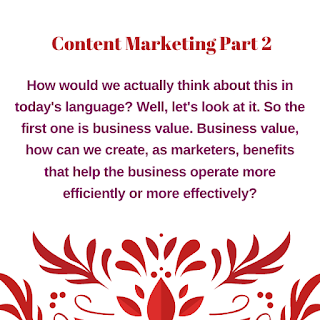Marketing would be providing insight into the business to produce and improve the production process. Then he talked about insight utility.
We would think of this, really, as market research today, into the ways that consumers use our products and services to make their lives better. So what can we do to help the consumers use products? What kind of features should we be adding? What kind of benefits of Content Marketing? How should we design the product? Basically, insights from market research to how do we make our products better, how do we improve the products themselves.
Then there's time utility.
This is probably the one that we would recognize the most as marketers today, which is how do we actually shorten the time between a marketer creating, and a business creating, a product to put into the marketplace, and the time that a consumer can get his or her hands on it.
This is what we think of as campaigns, promotions, advertising, marketing brochures, really persuading people to buy our product or service, and shortening the time, by the time it's going to sit on the shelf before it gets into a customer's hands. We know this utility really well these days.
And then finally there's possession utility, which for Arch Shaw was really the idea of how do we enable consumers to use our products better? How do we give them how-tos?
How do we instruct them? How do we get them to use the most, and get the most, out of the products and services that they're buying for us?
We might even think of this is what Jay Baer would call utility content. Utility content, where we can teach our customers how to use our products in the most optimal way, that they become loyal, that they become advocates for our particular brand.
So those are the four marketing utilities. Now what I want to do here is reset. I want to reset to today's language.
How would we actually think about this in today's language? Well, let's look at it. So the first one is business value. Business value, how can we create, as marketers, benefits that help the business operate more efficiently or more effectively?
That's a key piece of what we can add value today as marketing. Or how about data value? The idea of how we can create data that helps us understand how we can market more effectively, advertise more effectively, decrease customer service costs, understand the consumer and what they need at a more intimate, intricate level, and how to sell our products more effectively.
Or when we look at campaign value, what he would call the different ways of shortening that time between product or service. What we would look at is, how do we create optimal campaigns, optimal direct marketing efforts, that help shorten that time, that help promote our product, and sell more of it, quite frankly? And then, customer value.
How do we create value with customers, so that they care about us? So that they're loyal, so that they advocate for our behalf on the social media channels that we're trying to become so prevalent on. So those are the four values really, reset to today's language. And if we look at that, that becomes the basis of an integrated marketing strategy, something we can really use to generate value for marketing.
So, OK. So now we've set this, right? We've set this wonderful experience up, and this is how we should be structuring marketing more broadly. Well, how does that even relate to content marketing? I believe the content is really the one thing, the only thing, quite frankly that supports every single one of those categories. We can develop multiple lines of value using content that speaks directly to our customers' needs and directly create all of that value for the business. We typically only focus on one, we typically focus on the campaign value. But how can we start to create content that creates multiple lines of value, and becomes much more strategic in our business?
So OK, so what is content? Let's reboot that whole idea, right? We think of content, and marketing content, and advertising, and catalogs, and all the wonderful kinds of things that we create from a content perspective, but what is content when it comes to content marketing, and how do we understand it?










No comments:
Post a Comment